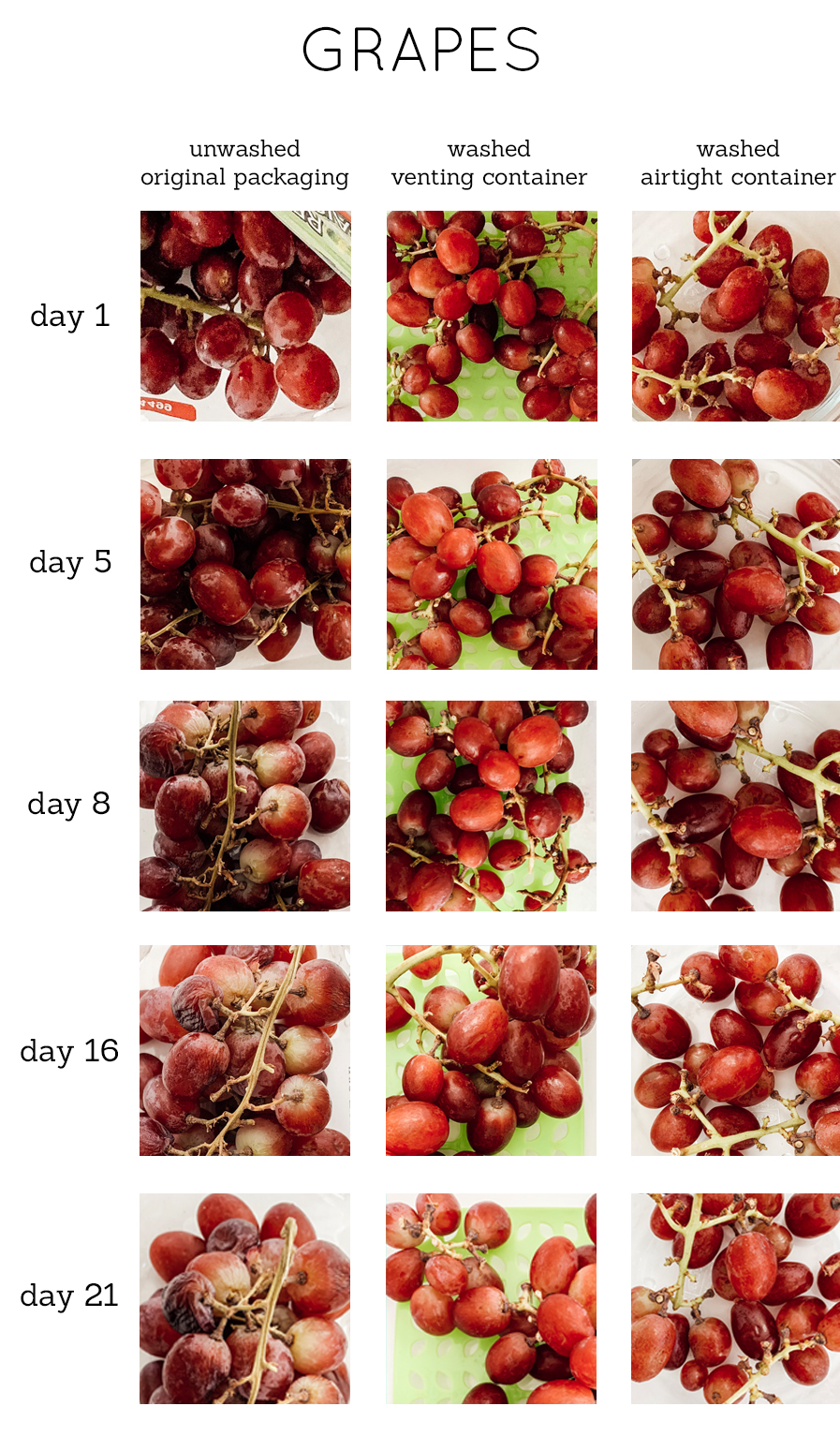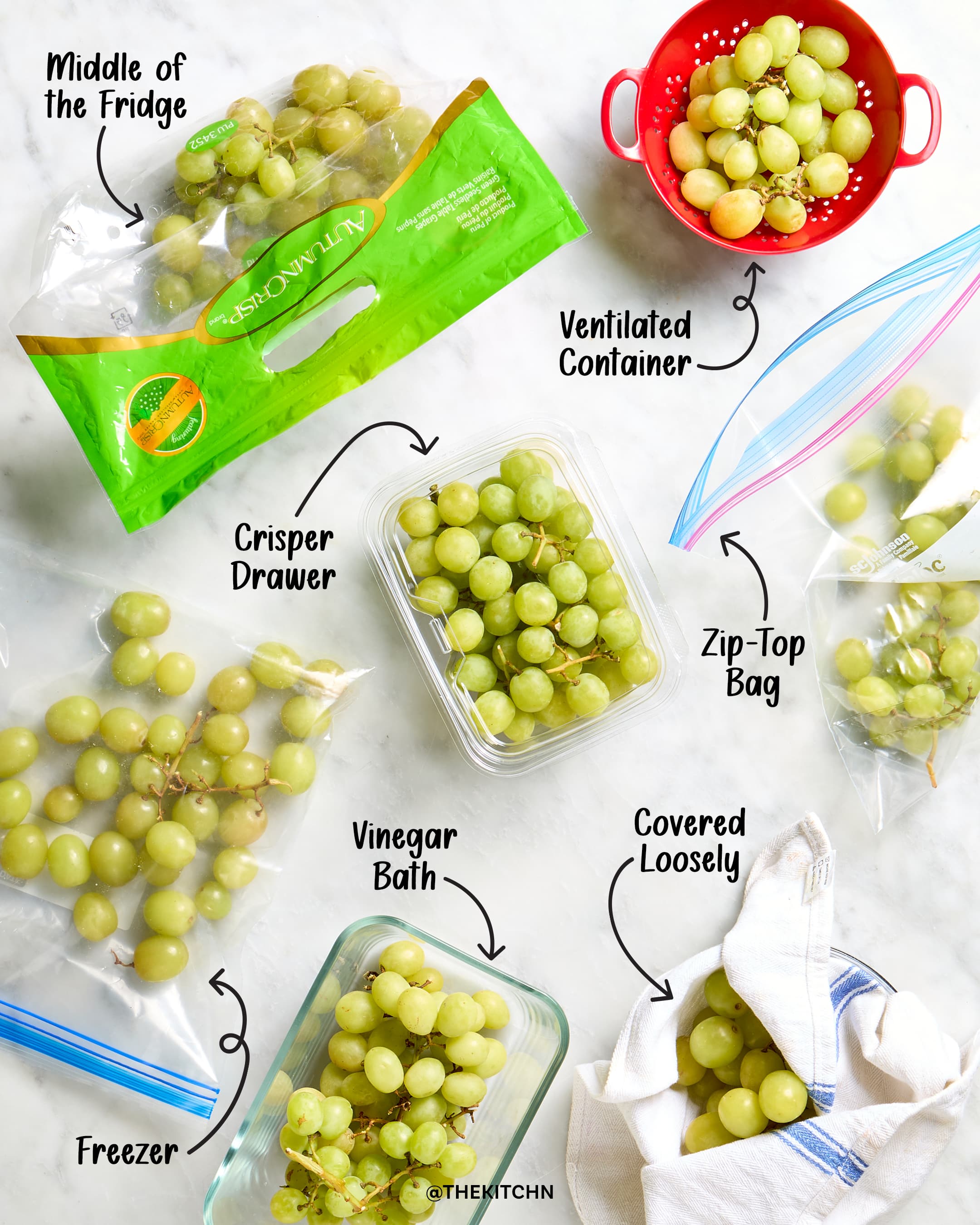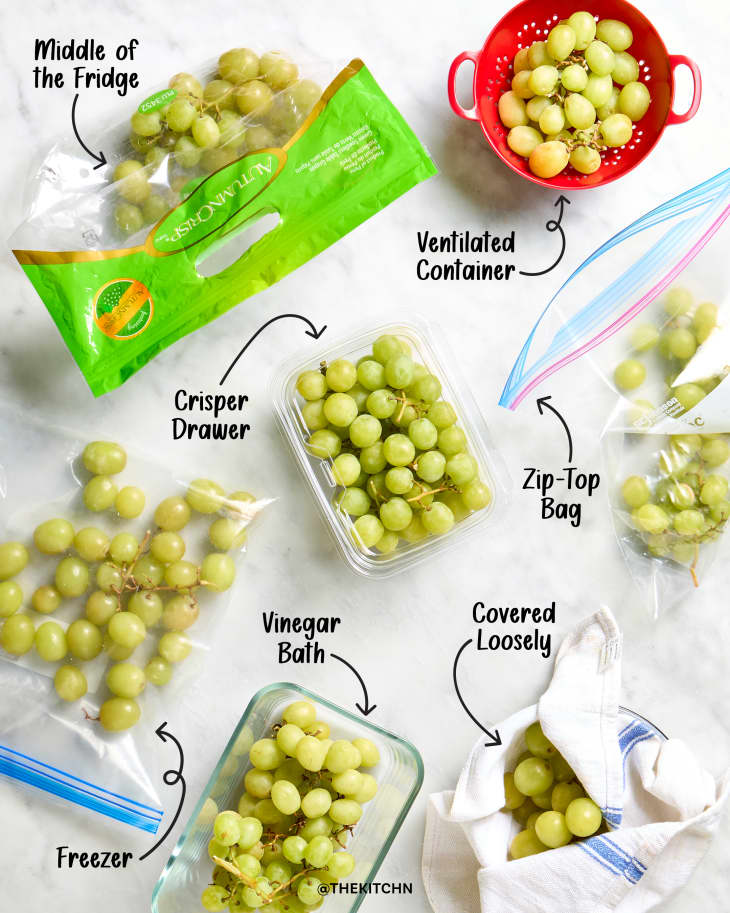Grapes are a delicious and healthy snack. But, keeping them fresh can be tricky.
Storing grapes the right way ensures they stay juicy and sweet for longer. Many people are unsure of the best methods to maintain their freshness. In this guide, we will explore simple and effective ways to store grapes. We will cover everything from the ideal temperature to the best containers.
By following these tips, you can enjoy your grapes at their best, whether for a quick snack or a special recipe. Let’s dive into the steps to keep your grapes fresh and tasty.
Choosing Fresh Grapes
Choosing fresh grapes is key to enjoying their sweet and juicy taste. Fresh grapes provide the best flavor and last longer when stored. Follow these tips to pick the best grapes for your needs.
Color And Firmness
Look for vibrant colors in your grapes. Green grapes should be a light green hue. Red and purple grapes should be deep and rich in color. Avoid dull or brownish grapes. They are likely past their prime.
Check the firmness of the grapes. Gently squeeze a grape to test its firmness. Fresh grapes will feel firm and plump. Soft or squishy grapes may be overripe or spoiled.
Avoiding Mold And Damage
Inspect the grapes for any signs of mold. Mold often appears as a white or gray powdery substance. Moldy grapes can spoil the entire bunch. Discard any grapes with visible mold.
Look for damaged grapes. Avoid grapes with broken skins or bruises. Damaged grapes spoil faster and can affect the rest of the bunch. Choose grapes with smooth, intact skins for the best quality.

Credit: homeandkind.com
Initial Preparation
Properly storing grapes begins with the right initial preparation. Follow these steps to ensure your grapes stay fresh longer. This guide covers the essential steps like washing and drying grapes. Let’s start with the basics.
Washing Grapes
First, place your grapes in a colander. Rinse them under cool running water. Make sure to remove any dirt or debris. Gently rub the grapes with your fingers. This helps clean the surface thoroughly. Avoid using soap or detergent. These can leave a residue.
Drying Properly
After washing, shake the colander to remove excess water. Lay the grapes on a clean, dry towel. Pat them dry with another towel. Ensure each grape is dry. Moisture can cause mold. Dry grapes last longer in storage. This step is crucial for preserving freshness.
Storage Temperature
Storing grapes properly ensures they remain fresh and tasty. The storage temperature is key. It impacts the longevity and quality of the grapes.
Ideal Temperature Range
Grapes store best at 30-32°F (about 0-1°C). This temperature slows down spoilage. It keeps the grapes firm and juicy. Use a refrigerator to maintain this temperature.
Avoiding Freezing
Do not let grapes freeze. Freezing damages their texture and taste. Keep grapes away from the freezer section. Check your fridge temperature settings. Ensure it does not drop below 30°F.
Refrigerator Storage
Storing grapes in the refrigerator can extend their freshness. Proper storage ensures that grapes stay crisp and tasty. This section will guide you on the best ways to store grapes in the refrigerator.
Using Crisper Drawers
Use the crisper drawers in your refrigerator. Crisper drawers help control humidity. Grapes thrive in a high-humidity environment. Place the grapes in the drawer. This keeps them fresh longer. Avoid overpacking the drawer. Air should circulate freely.
Best Containers
Store grapes in breathable containers. Perforated plastic bags work well. They allow air to circulate. This prevents moisture buildup. Avoid washing grapes before storing. Moisture speeds up spoilage. Wash grapes only before eating. You can also use a shallow container. Spread the grapes out. This keeps them from squashing each other.
Freezing Grapes
Freezing grapes is a great way to extend their shelf life. It preserves their taste and nutritional value. Frozen grapes make a refreshing snack. They are also handy for smoothies and desserts. Learn how to freeze and thaw grapes properly below.
Freezing Process
Start by washing the grapes thoroughly. Remove any stems and damaged grapes. Pat the grapes dry using a clean towel. Arrange the grapes in a single layer on a baking sheet. Ensure they don’t touch each other. Place the baking sheet in the freezer for about two hours.
Once the grapes are frozen, transfer them to a freezer-safe bag. Label the bag with the date. Store the bag in the freezer. Frozen grapes can last up to a year. Freezing them individually prevents them from sticking together.
Thawing Tips
Thaw grapes in the refrigerator for a few hours. This keeps them firm and tasty. For a quicker option, leave the grapes at room temperature for 30 minutes.
Use thawed grapes in salads or as a snack. They will be soft but still delicious. Avoid microwaving grapes to thaw them. This method can make them mushy.
:strip_icc()/BHG-how-to-store-grapes-7551763-hero-01_9671-d0864b1581464324a28f4b7d1de5443f.jpg)
Credit: www.bhg.com
Avoiding Ethylene Exposure
Grapes are a delicious and healthy snack, but storing them correctly can be a challenge. One of the key factors in maintaining their freshness is avoiding exposure to ethylene. Ethylene is a natural gas produced by certain fruits that can accelerate the ripening process and spoil your grapes faster. Understanding how to keep grapes away from ethylene-producing fruits is essential.
Ethylene-producing Fruits
Some fruits produce high levels of ethylene gas. It’s important to know which fruits these are so you can store your grapes separately. Here are some common ethylene-producing fruits:
- Apples
- Bananas
- Pears
- Peaches
- Tomatoes
Keeping your grapes away from these fruits will help them stay fresh longer. Ethylene gas can cause grapes to soften and spoil quickly.
Separate Storage
To avoid ethylene exposure, store grapes in a separate compartment in your fridge. Use the crisper drawer if possible. This drawer is designed to keep fruits and vegetables fresh by controlling humidity levels.
If your fridge has multiple crisper drawers, use one drawer for ethylene-producing fruits and another for grapes. This will create a barrier that helps protect your grapes.
Another tip is to use perforated plastic bags for storing grapes. These bags allow air circulation, which helps maintain freshness. Avoid sealing grapes in airtight containers as this can trap moisture and cause them to spoil faster.
For added protection, you can wrap the stems of grape bunches in a damp paper towel. This keeps the stems from drying out, which helps the grapes stay fresh longer.
By following these simple steps, you can enjoy fresh and delicious grapes for a longer period.
Travel And Transport
Transporting grapes can be tricky. Keeping them fresh during travel requires careful planning. Grapes are delicate and need proper handling to maintain their quality. Here are some tips to store grapes during travel.
Packing For Travel
Start by choosing the right container. Use a shallow, breathable container. This prevents grapes from being crushed. Line the container with paper towels. They absorb excess moisture.
Place grapes in a single layer. Avoid stacking them. This reduces the risk of bruising. Cover the grapes with another paper towel. It keeps them dry and fresh.
Seal the container loosely. Grapes need some airflow. Tight seals trap moisture and cause mold. A breathable cover is best. You can use plastic wrap with small holes.
Maintaining Freshness
Keep grapes cool during travel. Use an insulated bag or cooler. Cold temperatures slow down spoilage. Add ice packs, but don’t let them touch the grapes directly. Use a barrier like a towel.
Check the grapes regularly. Remove any damaged ones. This prevents the spread of mold. Fresh grapes should be firm and free of spots.
If traveling long distances, consider freezing grapes. Frozen grapes make a tasty snack. They can also be thawed and used in recipes. Freeze grapes on a baking sheet first. Then transfer them to a freezer bag.
Here’s a quick reference table:
| Step | Action |
|---|---|
| 1 | Choose a shallow, breathable container |
| 2 | Line with paper towels |
| 3 | Place grapes in a single layer |
| 4 | Cover with paper towel |
| 5 | Seal loosely with breathable cover |
| 6 | Keep cool with insulated bag and ice packs |
| 7 | Check regularly, remove damaged grapes |
| 8 | Consider freezing for long distances |
Signs Of Spoilage
Properly storing grapes ensures they remain fresh and tasty for a longer time. But how do you know if your grapes have gone bad? Recognizing the signs of spoilage is crucial to avoid consuming spoiled fruit. Let’s dive into the key indicators of spoiled grapes and the best ways to dispose of them safely.
Identifying Spoiled Grapes
First, examine the grape’s skin. Spoiled grapes often have wrinkles or shriveled skins. Also, look for any mold growth. Mold appears as white or gray fuzz on the surface. You might also notice an off smell. Fresh grapes have a mild, pleasant fragrance. If they smell sour or fermented, they are likely spoiled.
Another sign is the texture. Fresh grapes are firm and plump. Spoiled grapes feel soft or mushy. Check for leaks too. Grapes that leak juice are likely bad. Discard any with broken skins or leaking juice immediately.
Safe Disposal
Once you identify spoiled grapes, dispose of them properly. Do not eat or use them. Put spoiled grapes in a sealed bag before throwing them away. This prevents mold spores from spreading. Proper disposal keeps your kitchen clean and safe.
Composting is another option. Spoiled grapes can be added to your compost bin. They break down and provide nutrients to the soil. Ensure they are free from any chemicals before composting.

Credit: www.thekitchn.com
Frequently Asked Questions
How To Store Grapes In The Fridge?
To store grapes in the fridge, keep them in their original packaging or a breathable bag. Avoid washing before storing to prevent moisture buildup, which can lead to mold.
Can You Freeze Grapes For Later Use?
Yes, you can freeze grapes. Wash and dry them thoroughly, then place them on a baking sheet to freeze. Once frozen, transfer them to a freezer bag.
How Long Do Grapes Last In The Refrigerator?
Grapes can last up to two weeks in the refrigerator. Ensure they are stored in a breathable bag and kept dry to maximize freshness.
Should Grapes Be Washed Before Storing?
No, grapes should not be washed before storing. Washing adds moisture, which can cause mold. Wash them just before eating.
Conclusion
Storing grapes properly keeps them fresh and delicious. Always wash and dry them first. Use a breathable container for better air flow. Store them in the fridge to maintain freshness. Avoid placing them near strong-smelling foods. Following these simple steps ensures your grapes stay tasty for longer.
Enjoy your fresh grapes anytime!
